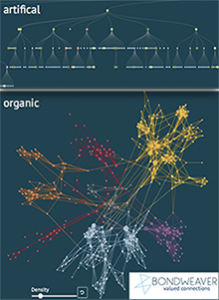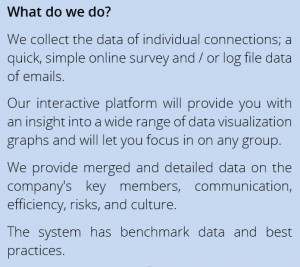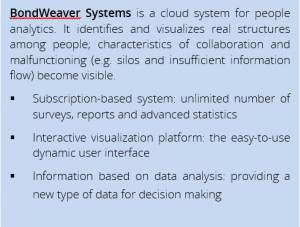“We will never understand complex systems unless we develop a deep understanding of the networks behind them.” Albert László Barabási, Harvard
 Not surprisingly, the constant urge to adapt motivates organisations to reorganize and continuously rebuild themselves with organisations of the future by restructuring their hierarchical system into a network of teams.
Not surprisingly, the constant urge to adapt motivates organisations to reorganize and continuously rebuild themselves with organisations of the future by restructuring their hierarchical system into a network of teams.
In every organisation there are two simultaneous structures:
◉ Artificial
◉ Organic
Planned and constructed structures are artificial. These include the organisation’s hierarchy, supply chains and project teams. Conventionally, these are designed by the organisation’s leaders and owners.
Organic structures are formed by the members of the community (e.g. employers and employees). These two networks generate reality together. Thus, the future challenge is to synchronize these networks according to the needs of the digital age.
Organisational Network Analysis (ONA) can visualize organic structures, creating the opportunity for synchronization.
Organisation Network Analysis
 ONA examines relationships between members (people, groups, communities) of an organisation. Unlike traditional analyses which explains behaviours according to personal attributes, ONA concentrates on connections between members of the organisation. Everyone has an impression or an opinion about how they connect to each other. Nevertheless, according to direct research even in smaller communities, they cannot precisely identify and see the network of their relationships. Biological researchers have found that we can only see the complete network of relationships in a community with up to 7 members and cannot grasp more than 150 relationships simultaneously.
ONA examines relationships between members (people, groups, communities) of an organisation. Unlike traditional analyses which explains behaviours according to personal attributes, ONA concentrates on connections between members of the organisation. Everyone has an impression or an opinion about how they connect to each other. Nevertheless, according to direct research even in smaller communities, they cannot precisely identify and see the network of their relationships. Biological researchers have found that we can only see the complete network of relationships in a community with up to 7 members and cannot grasp more than 150 relationships simultaneously.
During ONA we analyse the patterns of different types of connections (communication, work cooperation, trust, etc.). The result is then mapped. It visualizes the relationships and key people providing a map of our thoughts about the company.
By applying this modern approach, you gain entirely new insights into the social mechanisms, communication and cooperation at all levels. The social network map of your company supports you in understanding, predicting and controlling the complex system within your company.
Organisational Network Analysis can answer the following questions:
◉ Who are the key people in the organisation?
◉ How does information flow within the organisation?
◉ What is cooperation like between entities?
◉ Who could form am innovative team?
◉ Who are the real talents worth investing in?
◉ Which employees may leave the organisation soon and who might follow?
To familiarise ourselves with the aspect of social network analysis, let’s see an example:
We analysed two different small groups of people within varying structures of a network. Each node represents a person; each line represents a potential channel for interpersonal communication.
Question: Which small group of people can solve problems with the highest speed and accuracy? Each group received the same problem. Each can only communicate with the designated others.
 Answer: The less centralized group (left) outperformed the centralized structure (right). But when we gave a task instead of a problem (tasks are completed, while problem require ideas to solve them), then hierarchy structures performed better.
Answer: The less centralized group (left) outperformed the centralized structure (right). But when we gave a task instead of a problem (tasks are completed, while problem require ideas to solve them), then hierarchy structures performed better.
“The efficiency of communities depends on the participants’ interactional network as much or more than it depends on everything else, such as combined knowledge with experiences, with IQ, with skills, etc.” – Alex Pentland, MIT
Organisational Network Analysis is a unique option to understand the company and its operation better. Why is ONA useful? First, we need to clarify what useful means. Useful is what:
◉ makes our decisions easier
◉ improves efficiency
◉ boosts the speed of change and makes it easier to achieve
Makes our decisions easier
ONA simplifies decision making because it measures behaviour and provides facts.
Question: We have three candidates for a manager position. Who is the most suitable?
Answer: BondWeaver Systems identifies the person who has the same or the most similar relationship network compared to the expected relationship network, who has more respect among employees and who is better integrated into the leader community.
Question: Why are group decisions slow?
Answer: When a decision is made in a group, it usually gets stuck at the first question, ‘What is the situation?’. ONA provides a map with data so the group can proceed to the most important question: ‘What shall we do?’.
Improves efficiency
Companies pursue stronger internal and external cooperation. They try to achieve this through forcing cooperation in many ways, for example, by applying matrix systems or other formal mechanisms. However, employees often find faster and more appropriate connections which don’t match artificial (formal) mechanisms.
Question: Why does information disappear?
Answer: The affected groups are often in silos. The connection between leadership hierarchy levels or organisational groups is not properly developed. They have to identify relationships that should be established to integrate diverse communities.
Boosts the speed of change and makes it easier to achieve
Question: How can we improve the acceptance of a new idea or behaviour?
Answer: Change can be adopted more quickly and pervasively through appropriate recognition and management of key employees. This helps eliminate risk and limit costly disruption simultaneously aligning the organisation with its business strategy.
BondWeaver Systems identifies key individuals and brokers who can help spread ideas and behaviours. It also reveals disconnected functions and individuals who need to be brought into communities.
If you would like more information about BondWeaver or about Organisational Network Analysis (ONA), please contact us at info@peoplefirstme.com

